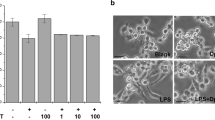Abstract
Antibacterial photodynamic therapy (PDT) has come to attract attention as an alternative therapy for drug-resistant bacteria. Recent reports revealed that antibacterial PDT induces innate immune response and stimulates abundant cytokine secretion as a part of inflammatory responses. However, the underlying mechanism how antibacterial PDT interacts with immune cells responsible for cytokine secretion has not been well outlined. In this study, we aimed to clarify the difference in gene expression and cytokine secretion between combined culture of fibroblasts and macrophages and their independent cultures. SCRC-1008, mouse fibroblast cell line and J774, mouse macrophage-like cell line were co-cultured and PDT treatments with different parameters were carried out. After various incubation periods (1–24 h), cells and culture medium were collected, and mRNA and protein levels for cytokines were measured using real-time PCR and ELISA, respectively. Our results showed that fibroblasts and macrophages interact with each other to mediate the immune response. We propose that fibroblasts initially respond to PDT by expressing Hspa1b, which regulates the NF-κB pathway via Tlr2 and Tlr4. Activation of the NF-κB pathway then results in an enhanced secretion of pro-inflammatory cytokines (TNF-α, IL-6 and IL-1β) and neutrophil chemoattractant MIP-2 and KC from macrophages.







Similar content being viewed by others
References
Tanaka M, Mroz P, Dai T, Huang L, Morimoto Y, Kinoshita M, et al. Photodynamic therapy can induce a protective innate immune response against murine bacterial arthritis via neutrophil accumulation. PLoS One. 2012;7(6):e39823. doi:10.1371/journal.pone.0039823.
Tanaka M, Kinoshita M, Yoshihara Y, Shinomiya N, Seki S, Nemoto K, et al. Photodynamic therapy using intra-articular photofrin for murine MRSA arthritis: biphasic light dose response for neutrophil-mediated antibacterial effect. Lasers Surg Med. 2011;43(3):221–9.
Asea A, Rehli M, Kabingu E, Boch JA, Baré O, Auron PE, et al. Novel signal transduction pathway utilized by extracellular HSP70: role of toll-like receptor (TLR) 2 and TLR4. J Biol Chem. 2002;277(17):15028–34.
Folkesson HG, Matthay MA, Hebert CA, Broaddus VC. Acid aspiration-induced lung injury in rabbits is mediated by interleukin-8-dependent mechanisms. J Clin Investig. 1995;96(1):107–16. doi:10.1172/JCI118009.
Porat R, Poutsiaka DD, Miller LC, Granowitz EV, Dinarello CA. Interleukin-1 (IL-1) receptor blockade reduces endotoxin and Borrelia burgdorferi-stimulated IL-8 synthesis in human mononuclear cells. FASEB J. 1992;6(7):2482–6.
Jourdan T, Godlewski G, Cinar R, Bertola A, Szanda G, Liu J, et al. Activation of the Nlrp3 inflammasome in infiltrating macrophages by endocannabinoids mediates beta cell loss in type 2 diabetes. Nat Med. 2013;19(9):1132–40.
Westwell-Roper CY, Ehses JA, Verchere CB. Resident macrophages mediate islet amyloid polypeptide-induced islet IL-1β production and β-cell dysfunction. Diabetes. 2014;63(5):1698–711. doi:10.2337/db13-0863.
Korbelik M, Sun J, Cecic I. Photodynamic therapy-induced cell surface expression and release of heat shock proteins: relevance for tumor response. Cancer Res. 2005;65(3):1018–26.
Luna MC, Ferrario A, Wong S, Fisher AMR, Gomer CJ. Photodynamic therapy-mediated oxidative stress as a molecular switch for the temporal expression of genes ligated to the human heat shock promoter. Cancer Res. 2000;60(6):1637–44.
Mambula SS, Calderwood SK. Heat shock protein 70 is secreted from tumor cells by a nonclassical pathway involving lysosomal endosomes. J Immunol. 2006;177(11):7849–57. doi:10.4049/jimmunol.177.11.7849.
Frasch SC, Henson PM, Nagaosa K, Fessler MB, Borregaard N, Bratton DL. Phospholipid flip-flop and phospholipid scramblase 1 (PLSCR1) co-localize to uropod rafts in formylated Met-Leu-Phe-stimulated neutrophils. J Biol Chem. 2004;279(17):17625–33. doi:10.1074/jbc.M313414200.
John K, Schreiber S, Kubelt J, Herrmann A, Müller P. Transbilayer movement of phospholipids at the main phase transition of lipid membranes: implications for rapid flip-flop in biological membranes. Biophys J. 2002;83(6):3315–23. doi:10.1016/S0006-3495(02)75332-0.
Asea A. Chaperokine-induced signal transduction pathways. Exerc Immunol Rev. 2003;9:25–33.
Botzler C, Li G, Issels RD, Multhoff G. Definition of extracellular localized epitopes of Hsp70 involved in an NK immune response. Cell Stress Chaperones. 1998;3(1):6–11.
Lawrence T. The nuclear factor NF-κB pathway in inflammation. Cold Spring Harb Perspect Biol. 2009;1(6):a001651. doi:10.1101/cshperspect.a001651.
Knott PG, Gater PR, Dunford PJ, Fuentes ME, Bertrand CP. Rapid up-regulation of CXC chemokines in the airways after Ag-Specific CD4+ T cell activation. J Immunol. 2001;166(2):1233–40. doi:10.4049/jimmunol.166.2.1233.
Miura M, Fu X, Zhang Q-W, Remick DG, Fairchild RL. Neutralization of Groα and macrophage inflammatory protein-2 attenuates renal ischemia/reperfusion injury. Am J Pathol. 2001;159(6):2137–45. doi:10.1016/S0002-9440(10)63065-9.
Roche JK, Keepers TR, Gross LK, Seaner RM, Obrig TG. CXCL1/KC and CXCL2/MIP-2 are critical effectors and potential targets for therapy of Escherichia coli O157:H7-associated renal inflammation. Am J Pathol. 2007;170(2):526–37. doi:10.2353/ajpath.2007.060366.
Acknowledgments
This study was supported in part of JSPS research Grant (to Y. Morimoto) and a Grant from Okinaka Memorial Institute for Medical Research (to Y. Morimoto). We thank M. Yano, A. Majima and Y. Iida (National Defense Medical College, NDMC) for their technical assistance.
Conflict of interest
The authors declare that they have no conflict of interest.
Author information
Authors and Affiliations
Corresponding author
Rights and permissions
About this article
Cite this article
Zulaziz, N., Azhim, A., Himeno, N. et al. Photodynamic therapy mediates innate immune responses via fibroblast–macrophage interactions. Human Cell 28, 159–166 (2015). https://doi.org/10.1007/s13577-015-0118-2
Received:
Accepted:
Published:
Issue Date:
DOI: https://doi.org/10.1007/s13577-015-0118-2




